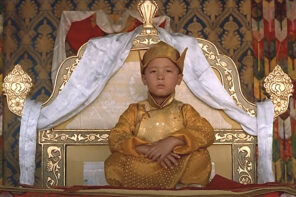On April 24 the global guru Sathya Sai Baba died at the age of 86 near his ashram in his home village of Puttaparti in Andhra Pradesh. Sai Baba had been admitted to the Sri Sathya Sai Institute of Higher Medical Sciences on March 28 and was on life support and dialysis as his condition gradually deteriorated until his eventual death from multiple organ failure.
Reflecting on Sai Baba’s life, one encounters moments of divine transformation, devotion, and public service as well as pain, death, and heinous accusations. Millions of devotees believed in and worshiped Sai Baba as a god-man, an avatar of God. Many also despised him as a charlatan, a sexual abuser, and even an accessory to murder.
Becoming God
Sai Baba was born as Sathyanarayana Raju on November 23, 1926 in Puttaparthi. In 1940, after recovering from seizures caused by a scorpion bite, his character transformed, and he claimed to be an incarnation of the turn of the century Muslim saint Shirdi Sai Baba. He renounced all normal social relationships and performed miracles that quickly attracted large crowds.
And so Sai Baba became a guru.
In 1963 Sai Baba disclosed that not only was he the incarnation of Shirdi Sai Baba, but he was also the incarnation of God himself, a God that transcends all religious boundaries. His ecumenical teaching maintained that all religions are true paths to God, and since Sai Baba is God, he is also is Shiva, Vishnu, Jesus, and Allah.
Sai Baba’s ability to attract devotees—whether attributed to his personal charisma, marketing skills, or both—was extraordinary. Today the International Sathya Sai Organization disseminates Sai Baba’s teachings and manages a network of over 1,200 Sathya Sai Baba centers in 126 countries. Most of his devotees came to acknowledge him as god-man without ever meeting him in person.
Sai Baba’s devotees include powerful politicians (including former prime ministers of India), celebrities, and entrepreneurs. Following his death, a wave of public condolences arose from powerful Indian politicians eager to confirm their associations with the god-man. (Although a separate article would be required to explain the dynamics of contemporary Indian politics when it comes to a controversial figure like Sai Baba.)
As Sai Baba’s devotees grew in numbers and influence so did his financial worth. In 1972 the Satya Sai Central Trust was set up. Today the trust is estimated to be worth at least $8.9 billion. It has funded water supply projects in poor areas of southern India as well as ashrams, hospitals, universities, and several schools across India and globally.
Sai Baba was most famous for his miracles—mainly materializations of valuable objects. He is believed to have had the power to conjure jewelry as gifts as well as sacred ash, which devotees applied to their tongues, throats, and foreheads. The guru was believed to miraculously heal the sick and to leave his body in order to visit people all over the world. For devotees, such miracles confirmed that Sai Baba was God incarnate.
Others disagreed.
Serious Scandal
Sai Baba’s reputation was tinged by accusations that he was a charlatan. Skeptics argued that his ability to materialize objects was not miraculous but the sign of a skilled conjuring magician.
Perhaps the most notable controversy surrounding the guru arose in 1993 when the police killed six young male devotees in Sai Baba’s bedroom and claimed that they did so in self-defense. The case remains controversial because many details of the incident are unknown. Some speculate that the men were not killed in self-defense but were murdered after they arrived to confront Sai Baba or perhaps kill him in retribution.
In retribution for what?
There are accusations that Sai Baba sexually abused some of his young male devotees. Such accusations received global attention when in 2004 the British Broadcasting Corporation (BBC) aired Secret Swami, a documentary featuring interviews with American male devotees who claimed that Sai Baba had coerced them as young men into sexual relationships. They described how he initiated them into such relationships by rubbing oil on their genitals and then proceeded to demand sexual favors, in some cases for years. One accuser described how Sai Baba threatened him, arguing that his failure to succumb to the guru’s demands would amount to a rejection of God himself—and that if he told his family about the sexual encounters, they would ostracize him in the name of Sai Baba.
Sai Baba denied the allegations and was never officially investigated nor charged with any crime in India.
Sai Baba’s life was a complex one to say the least, and it calls into question how we use the term guru in our popular discourse. Terms for religious exemplars, such as saint or guru, occur widely in the popular media and in popular culture generally in reference to figures assumed to embody ethical virtue. I encounter this assumption often in my undergraduate courses when I teach about saints or gurus and discuss the all too frequent accusations of sexual abuse that surround such figures.
Many students inevitably ask, in shock and horror, how such figures can be both religious exemplars and abusers.
So how can Sai Baba, a global guru loved by many and simultaneously marred by controversy, be both a religious exemplar as guru and god-man and an abuser, a cheat, and/or an accessory to murder?
On the one hand, devotees claim that their charitable service to less fortunate communities is substantial and is a direct consequence of Sai Baba’s teachings and transformative effects in their lives. And money from the Satya Sai Central Trust has been used to improve the lives of hundreds of thousands of people living in poor conditions.
On the other hand, accusations that he used fraudulent magic to coerce devotees, threatened young men to have sex with him lest they disobey God himself, and perhaps even participated as an accessory to murder are impossible to ignore.
If any one of these accusations is true it is difficult to consider Sai Baba a guru— assuming that term has something to do with ethical virtue.
But the history of religions is tinged by religious exemplars with questionable ethics. By destabilizing popular assumptions about gurus, it becomes possible to adequately evaluate Sai Baba’s life and to bracket—and even denounce—his ethics while still acknowledging the transformative effects he had on his devotees. In this case the term guru would point not to individuals with exceptional virtue, but rather to those who have the power to convince, to lead, and to instigate transformation among disciples.
In Sai Baba’s case, this much, at least, is true.




